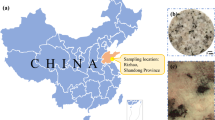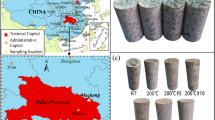Abstract
A liquid nitrogen cold-shock fracturing method is proposed to resolve the problem of single heat-exchange cracks generated by hydraulic fracturing in an enhanced geothermal system. A complex crack network can be constructed from the great thermal difference between cryogenic fluids and hot rocks. In this work, damage characterization that combined resistivity, ultrasonic wave, and nuclear magnetic resonance (NMR) was undertaken. The matrix continuity was analyzed ultrasonically, the fracture channel was analyzed by resistivity, and the pore structure was analyzed by NMR. The high-temperature granite damage after liquid nitrogen cold-shocking was evaluated quantitatively. The ultrasonic velocities of the granite cores decreased with high temperature, especially over 400 °C. The resistivity decreased and the largest drop was 81.86% for granite C at 600 °C. According to the NMR T2 spectra, liquid nitrogen cold-shocking expanded the pore volume and increased the pore number. The porosity after cold-shocking increased exponentially with heating temperature, where the porosities of granites A, B, and C reached 7.21%, 4.29%, and 3.10%, respectively. The damage variables calculated by wave velocity and resistivity increased with heating temperatures. The correlation of porosity with resistivity and wave velocity was established by multiple linear regression. Liquid nitrogen cold-shocking induced a developed pore-fracture network in hot dry rocks.



























Similar content being viewed by others
References
Aliyu, M. D., & Archer, R. A. (2021). Numerical simulation of multifracture HDR geothermal reservoirs. Renewable Energy, 164, 541–555.
Caulk, R. A., Ghazanfari, E., Perdrial, J. N., & Perdrial, N. (2016). Experimental investigation of fracture aperture and permeability change within Enhanced Geothermal Systems. Geothermics, 62, 12–21.
Chaki, S., Takarli, M., & Agbodjan, W. P. (2008). Influence of thermal damage on physical properties of a granite rock: Porosity, permeability and ultrasonic wave evolutions. Construction and Building Materials, 22(7), 1456–1461.
Collin, M., & Rowcliffe, D. (2002). The morphology of thermal cracks in brittle materials. Journal of the European Ceramic Society, 22(4), 435–445.
Cong, Y., Zhai, C., Sun, Y., Xu, J., Tang, W., & Zheng, Y. F. (2021). Visualized study on the mechanism of temperature effect on coal during liquid nitrogen cold shock. Applied Thermal Engineering, 194, 116988.
Ding, S., Jia, H. L., Zi, F., Dong, Y. H., & Yao, Y. (2020). Frost Damage in tight sandstone: Experimental evaluation and interpretation of damage mechanisms. Materials, 13(20), 4617.
Fan, Y., Xing, D., Deng, S., Li, R., & Ge, X. (2015). Acoustic properties of low permeability cores and its application to reservoir gas predication. Journal of Southwest Petroleum University (Science & Technology Edition), 37(5), 64–70.
Gautam, P. K., Verma, A. K., Jha, M. K., Sarkar, K., Singh, T. N., & Bajpai, R. K. (2016). Study of strain rate and thermal damage of dholpur sandstone at elevated temperature. Rock Mechanics and Rock Engineering, 49(9), 3805–3815.
Grundmann, S. R., Rodvelt, G. D., Dials, G. A., & Allen, R. E. (1998). Cryogenic nitrogen as a hydraulic fracturing fluid in the devonian shale. In SPE Eastern Regional Meeting (OnePetro).
Hu, Q., Song, M., Li, Q., Wu, Y., Xu, Y., Zhang, Y., & Deng, Y. (2021). Analysis of resistivity response of stratified briquette during uniaxial compression. Journal of China Coal Society, 46(1), 211–219.
Igarashi, G., Maruyama, I., Nishioka, Y., & Yoshida, H. (2015). Influence of mineral composition of siliceous rock on its volume change. Construction and Building Materials, 94, 701–709.
Jin, J., Li, X., Yin, Z., & Zou, Y. (2011). A method for defining rock damage variable bywave impedance under cyclic impact loadings. Rock and Soil Mechanics, 32(5), 1385–1393.
Kahraman, S., & Alber, A. (2006). Predicting the physico-mechanical properties of rocks from electrical impedance spectoscopy measurements. International Journal of Rock Mechanics and Mining Sciences, 43(4), 543–553.
Kimura, M. (2018). Prediction of tortuosity, permeability, and pore radius of water-saturated unconsolidated glass beads and sands. The Journal of the Acoustical Society of America, 143(5), 3154–3168.
Kumari, W. G. P., Ranjith, P. G., Perera, M. S. A., Chen, B. K., & Abdulagatov, I. M. (2017). Temperature-dependent mechanical behaviour of Australian Strathbogie granite with different cooling treatments. Engineering Geology, 229, 31–44.
Kumari, W. G. P., Ranjith, P. G., Perera, M. S. A., Li, X., Li, L. H., Chen, B. K., Isaka, B. L. A., & De Silva, V. R. S. (2018). Hydraulic fracturing under high temperature and pressure conditions with micro CT applications: Geothermal energy from hot dry rocks. Fuel, 230, 138–154.
Lemaitre, J., & Dufailly, J. (1987). Damage measurements. Engineering Fracture Mechanics, 28(5–6), 643–661.
Li, J. L., Kaunda, R. B., & Zhou, K. P. (2018). Experimental investigations on the effects of ambient freeze-thaw cycling on dynamic properties and rock pore structure deterioration of sandstone. Cold Regions Science and Technology, 154, 133–141.
Li, R., Yan, Y., & Huang, Z. (2020). Thermal and mechanical analysis of LN2 jet impinging on rock surface. Applied Thermal Engineering, 178, 115581.
Liu, T., Liu, X. W., & Zhu, T. Y. (2020). Joint analysis of P-wave velocity and resistivity for morphology identification and quantification of gas hydrate. Marine and Petroleum Geology, 112, 104036.
Lu, S. M. (2018). A global review of enhanced geothermal system (EGS). Renewable & Sustainable Energy Reviews, 81, 2902–2921.
Mahesar, A. A., Shar, A. M., Ali, M., Tunio, A. H., Uqailli, M. A., Mohanty, U. S., Akhondzadeh, H., Iglauer, S., & Keshavarz, A. (2020). Morphological and petro physical estimation of Eocene tight carbonate formation cracking by cryogenic liquid nitrogen; A case study of Lower Indus basin, Pakistan. Journal of Petroleum Science and Engineering, 192, 107318.
McDaniel, B. W., Grundmann, S. R., Kendrick, W. D., Wilson, D. R., & Jordan, S. W. (1997). Field applications of cryogenic nitrogen as a hydraulic fracturing fluid. In SPE Annual Technical Conference and Exhibition (OnePetro).
Nasseri, M. H. B., Schubnel, A., & Young, R. P. (2007). Coupled evolutions of fracture toughness and elastic wave velocities at high crack density in thermally treated Westerly granite. International Journal of Rock Mechanics and Mining Sciences, 44(4), 601–616.
Ohno, I. (1995). Temperature variation of elastic properties of α-quartz up to the α-β transition. Journal of Physics of the Earth, 43(2), 157–169.
Qi, H., Ba, J., & Muller, T. M. (2021). Temperature effect on the velocity-porosity relationship in rocks. Journal of Geophysical Research: Solid Earth, 126(1), e2019JB019317.
Qin, L., Ma, C., Li, S., Lin, H., Wang, P., Long, H., & Yan, D. J. (2022). Mechanical damage mechanism of frozen coal subjected to liquid nitrogen freezing. Fuel, 309, 122124.
Qin, Y., Tian, H., Xu, N. X., Zhang, Y., & Han, J. (2015). Experimental study on partial physical properties of post-high-temperature diorite. Chinese Journal of Geotechnical Engineering, 37(7), 1226–1231.
Ranade, R., Zhang, J., Lynch, J. P., & Li, V. C. (2014). Influence of micro-cracking on the composite resistivity of engineered cementitious composites. Cement and Concrete Research, 58, 1–12.
Sirdesai, N. N., Mahanta, B., Ranjith, P. G., & Singh, T. N. (2019). Effects of thermal treatment on physico-morphological properties of Indian fine-grained sandstone. Bulletin of Engineering Geology and the Environment, 78(2), 883–897.
Somerton, W. H., & Rybach, L. (1993). Thermal properties and temperature-related behavior of rock/fluid systems. Journal of Volcanology and Geothermal Research, 56, 171–171.
Soprani, S., Marongiu, F., Christensen, L., Alm, O., Petersen, K. D., Ulrich, T., & Engelbrecht, K. (2019). Design and testing of a horizontal rock bed for high temperature thermal energy storage. Applied Energy, 251, 113345.
Sun, Q., & Hu, J. (2021). Effects of heating on some physical properties of granite, Shandong, China. Journal of Applied Geophysics, 193, 104410.
Sun, Y., Zhai, C., Xu, J. Z., Cong, Y. Z., Qin, L., & Zhao, C. (2020). Characterisation and evolution of the full size range of pores and fractures in rocks under freeze-thaw conditions using nuclear magnetic resonance and three-dimensional X-ray microscopy. Engineering Geology, 271, 105616.
Watanabe, T., Makimura, M., Kaiwa, Y., Desbois, G., Yoshida, K., & Michibayashi, K. (2019). Elastic wave velocity and electrical conductivity in a brine-saturated rock and microstructure of pores. Earth, Planets and Space, 71(1), 1–12.
Wu, X., Huang, Z., Cheng, Z., Zhang, S., Song, H., & Zhao, X. (2019a). Effects of cyclic heating and LN2-cooling on the physical and mechanical properties of granite. Applied Thermal Engineering, 156, 99–110.
Wu, X., Huang, Z., Song, H., Zhang, S., Cheng, Z., Li, R., Wen, H., Huang, P., & Dai, X. (2019b). Variations of physical and mechanical properties of heated granite after rapid cooling with liquid nitrogen. Rock Mechanics and Rock Engineering, 52(7), 2123–2139.
Wu, X., Huang, Z., Zhang, S., Cheng, Z., Li, R., Song, H., Wen, H., & Huang, P. (2019c). Damage analysis of high-temperature rocks subjected to LN2 thermal shock. Rock Mechanics and Rock Engineering, 52(8), 2585–2603.
Wu, Y., Li, X.-Z., Huang, Z., & Xue, S. (2021). Effect of temperature on physical, mechanical and acoustic emission properties of Beishan granite, Gansu Province, China. Natural Hazards, 107(2), 1577–1592.
Wu, Z., Li, M., & Weng, L. (2020). Thermal-stress-aperture coupled model for analyzing the thermal failure of fractured rock mass. International Journal of Geomechanics, 20(10), 04020176.
Wyllie, M. R. J., Gregory, A. R., & Gardner, L. W. J. G. (1956). Elastic wave velocities in heterogeneous and porous media. Geophysics, 21(1), 41–70.
Xu, J. Z., Zhai, C., Liu, S. M., Qin, L., & Dong, R. W. (2018). Investigation of temperature effects from LCO2 with different cycle parameters on the coal pore variation based on infrared thermal imagery and low-field nuclear magnetic resonance. Fuel, 215, 528–540.
Xu, J. Z., Zhai, C., Ranjith, P. G., Sun, Y., & Qin, L. (2019). Petrological and ultrasonic velocity changes of coals caused by thermal cycling of liquid carbon dioxide in coalbed methane recovery. Fuel, 249, 15–26.
Yin, D., & Xu, Q. (2020). Comparison of sandstone damage measurements based on non-destructive testing. Materials, 13(22), 5154.
Zhang, S., Huang, Z., Huang, P. P., Wu, X. G., Xiong, C., & Zhang, C. C. (2018a). Numerical and experimental analysis of hot dry rock fracturing stimulation with high-pressure abrasive liquid nitrogen jet. Journal of Petroleum Science and Engineering, 163, 156–165.
Zhang, S., Huang, Z., Zhang, H., Guo, Z., Wu, X., Wang, T., Zhang, C., & Xiong, C. (2018b). Experimental study of thermal-crack characteristics on hot dry rock impacted by liquid nitrogen jet. Geothermics, 76, 253–260.
Zhao, Z., Liu, Z., Pu, H., & Li, X. (2018). Effect of thermal treatment on brazilian tensile strength of granites with different grain size distributions. Rock Mechanics and Rock Engineering, 51(4), 1293–1303.
Zhu, S., Zhang, W., Sun, Q., Deng, S., Geng, J., & Li, C. (2017). Thermally induced variation of primary wave velocity in granite from Yantai: Experimental and modeling results. International Journal of Thermal Sciences, 114, 320–326.
Acknowledgments
This work was financially supported by the National Natural Science Foundation of China (51774278), the National Science Fund for Distinguished Young Scholars (51925404), the Fundamental Research Funds for the Central Universities (2023QN1060), the China Postdoctoral Science Foundation (2021M693409), the National Natural Science Foundation of China (52104228, 52104233), and 21 Jiangsu Shuangchuang (Mass Innovation and Entrepreneurship) Talent Program (JSSCBS20211235).
Author information
Authors and Affiliations
Corresponding author
Ethics declarations
Conflict of Interest
The author declare that they have no known competing financial interests or personal relationship that could have appeared to influence the work reported in this paper.
Rights and permissions
Springer Nature or its licensor (e.g. a society or other partner) holds exclusive rights to this article under a publishing agreement with the author(s) or other rightsholder(s); author self-archiving of the accepted manuscript version of this article is solely governed by the terms of such publishing agreement and applicable law.
About this article
Cite this article
Sun, Y., Zhai, C., Yu, X. et al. Pore Structure and Damage Evaluation of Hot Dry Rocks in Enhanced Geothermal System by Combining Electrical Resistivity, Ultrasonic Waves and Nuclear Magnetic Resonance. Nat Resour Res 32, 1559–1578 (2023). https://doi.org/10.1007/s11053-023-10210-7
Received:
Accepted:
Published:
Issue Date:
DOI: https://doi.org/10.1007/s11053-023-10210-7




